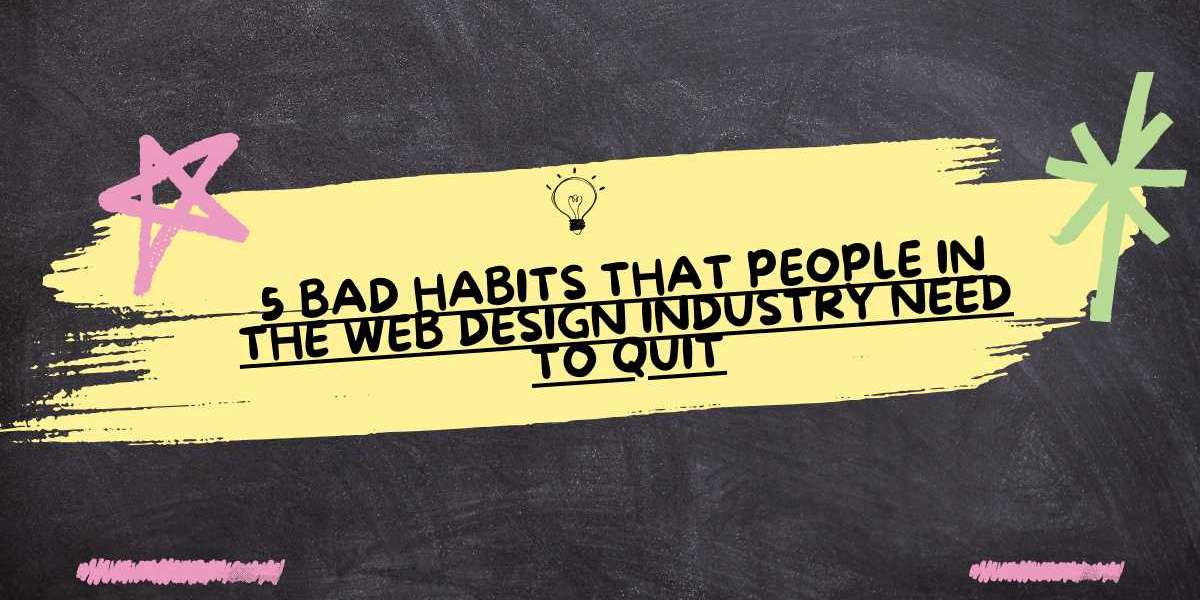Introduction
The web design industry thrives on creativity, innovation, and attention to detail. However, even the most talented designers can fall into bad habits that hinder their productivity, harm their projects, or frustrate their clients. Recognizing and overcoming these habits is critical to staying ahead in this competitive field. In this blog, we’ll explore five bad habits that web designers should quit and provide actionable solutions to help elevate your work to the next level. Many web design packages offer additional services like logo creation, digital marketing, and hosting for a comprehensive online solution.
1. Ignoring User Experience (UX)
The Habit:
Some web designers focus too much on aesthetics and neglect user experience (UX). They prioritize flashy designs, animations, and unconventional layouts that may look impressive but fail to serve the end user effectively.
Why It’s Harmful:
A visually stunning website is meaningless if users find it difficult to navigate or understand. Ignoring UX can lead to high bounce rates, low engagement, and a poor reputation for your clients.
How to Quit:
- Understand Your Audience: Conduct thorough research on your target audience’s preferences and behavior.
- Prioritize Simplicity: Ensure navigation is intuitive, and key information is easy to find.
- Test Your Designs: Regularly conduct usability tests to identify pain points and gather user feedback.
- Learn UX Principles: Familiarize yourself with UX best practices to integrate them into your designs.
2. Overloading Websites with Features
The Habit:
By working with Birmingham web designers, you can improve your site’s search engine ranking and visibility. Some designers try to include every possible feature, plugin, or element in a single website, believing more is always better.
Why It’s Harmful:
Feature overload can slow down the website, confuse users, and make maintenance more complex. A cluttered interface also dilutes the brand message and reduces the overall impact.
How to Quit:
- Focus on Core Features: Only include features that add value to the user experience.
- Embrace Minimalism: A clean, well-organized design is often more effective than a feature-packed site.
- Communicate with Clients: Help clients prioritize features that align with their business goals.
- Optimize Performance: Regularly test your website’s speed and eliminate unnecessary elements.
3. Neglecting Mobile Responsiveness
The Habit:
Despite mobile-first design being a standard, some web designers still prioritize desktop layouts and treat mobile responsiveness as an afterthought. A photography logo maker lets you easily adjust your design to suit different branding materials.
Why It’s Harmful:
With over 50% of web traffic coming from mobile devices, a lack of responsiveness can alienate a significant portion of your audience. It also harms your site’s SEO ranking, as search engines prioritize mobile-friendly websites.
How to Quit:
- Adopt Mobile-First Design: Start with the mobile layout and scale up for larger screens.
- Test Across Devices: Use tools like Google’s Mobile-Friendly Test to ensure compatibility across devices.
- Optimize Content for Mobile: Use legible fonts, scalable images, and touch-friendly navigation.
- Stay Updated: Keep up with emerging trends and best practices in mobile web design.
4. Skipping Regular Maintenance
The Habit:
Many web designers consider their job done after the website launch, neglecting regular updates, security patches, and performance checks.
Why It’s Harmful:
Without ongoing maintenance, websites become vulnerable to security threats, broken links, outdated content, and declining performance. This not only frustrates users but also damages the client’s reputation.
How to Quit:
- Offer Maintenance Plans: Provide clients with post-launch maintenance packages.
- Schedule Regular Updates: Set reminders for updating plugins, themes, and software.
- Monitor Performance: Use analytics tools to track speed, traffic, and user behavior.
- Address Issues Promptly: Fix broken links, outdated content, or bugs as soon as they arise.
5. Poor Communication with Clients
The Habit:
Some designers fail to communicate effectively with clients, using overly technical jargon or not providing updates during the project.
Why It’s Harmful:
Poor communication leads to misunderstandings, unmet expectations, and dissatisfied clients. It can also result in multiple revisions, wasting time and resources.
How to Quit:
- Set Clear Expectations: Discuss timelines, deliverables, and project scope upfront.
- Provide Regular Updates: Keep clients informed at every stage of the project.
- Use Layman’s Terms: Explain design choices and technical aspects in simple language.
- Be Open to Feedback: Actively listen to client suggestions and address concerns promptly.
FAQs
Q1: Why is user experience (UX) so important in web design?
A1: UX focuses on how users interact with a website. A positive UX ensures that visitors can easily navigate the site, find information, and complete desired actions, leading to higher engagement and conversions.
Q2: How can I make a website more mobile-friendly?
A2: Start with a mobile-first design approach, use responsive frameworks like Bootstrap, optimize images for faster loading, and ensure touch-friendly navigation. Regularly test the site on multiple devices.
Q3: How often should a website be maintained?
A3: Websites should undergo maintenance at least once a month. This includes updating software, fixing bugs, optimizing performance, and ensuring all features are functioning correctly.
Q4: What tools can help improve client communication in web design?
A4: Tools like Trello, Asana, Slack, and Figma allow seamless collaboration, project tracking, and real-time feedback, improving communication between designers and clients.
Q5: Is minimalism in web design always better?
A5: While minimalism is often effective, it’s not a one-size-fits-all solution. The design approach should align with the brand’s identity, audience, and goals.
Conclusion
Web design is a dynamic industry that requires constant learning and adaptability. Breaking bad habits like neglecting UX, overloading features, ignoring mobile responsiveness, skipping maintenance, and poor communication is essential for professional growth and client satisfaction. By embracing best practices and focusing on creating value-driven designs, web designers can elevate their work and achieve long-term success in the competitive digital landscape. Start by evaluating your habits today—what can you improve to become a better web designer? Laravel hosting ensures a smooth and fast user experience, making it ideal for complex and dynamic web applications.








